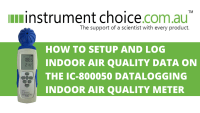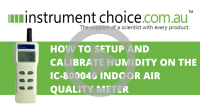How to Setup and Use the IC-WR-3 Scarlet Wireless Anemometer

The IC-WR-3 is an accurate, long-range, and portable wireless anemometer, suited for both permanent and temporary installations. The sensor sends data to the display unit every two seconds so that you will have instantaneous wind speed readings within a 400m radius from the sensor.
The IC-WR-3 is versatile and ideal for use in applications such as determining wind speed in the vicinity of cranes and lifting equipment, construction sites, outdoor venues, marine applications, as well as various applications in agriculture.
Figure 1 Watch an Instrument ChoiceScientistSetup and Use the Scarlet Wireless Anemometer here.
How to Setup and Use the Scarlet Wireless Anemometer
You will need
- Display Unit
- Sensor Unit
- Two AA Batteries
- Assemble the anemometer sensor unit. The wind cups click onto the shaft on top of the sensor. Note: The battery is pre-installed into the sensor. This battery is exceptionally long-lasting; however, when 'Lb' starts appearing on the display screen, the battery will need to be replaced.
- Insert batteries into the display unit. Slide off the rear battery cover on the receiving console and Insert two AA batteries. Replace the lid and press the right 'Light/Power' button to turn on
- The sensor unit and display unit will automatically connect. The temperature sensor is located within the anemometer sensor. It can take up to 30-minutes for the temperature sensor to record the surrounding air temperature.
- Press the left 'F' button, and you can select between four different display modes. The top half of the screen will display wind speed and pressing 'F' adjusts the bottom half.
- Mode 1: Displays the temperature.
- Mode 2: 'Ch' is windchill. Ch and the wind chill reading will alternate on the screen.
- Mode 3: Maximum wind speed. Reset the maximum recorded speed at any time by pressing the left button for two seconds while in this mode.
- Mode 4: Average speed/ current speed, depending on the setting.
- On this unit, you can also adjust the settings. Enter the settings menu by pressing the left 'F' button for four seconds. The menu items will start appearing on the screen. To adjust any of the options, release the 'F' button and press the left and right buttons to select the desired unit. Menus include;
- Menu 1: Alarm limit setting. Set the wind speed alarm limit. When the limit is exceeded 'Hi' will blink on the display unit.
- Menu 2: Averaging period. Available averaging period options are 10 seconds, 30 seconds, 2 minutes and 5 minutes.
- Menu 3: Sensor address. Here you can set the address to correspond to the sensor you wish to read. The address of the sensor is located on the sensor and inside the battery compartment.
- Menu 4: Wind speed units. Select between m/s, km/h, knots and mph.
- Menu 5: Temperature unit selection. Select between Celcius and Fahrenheit.
- When selected, press no buttons for 5 seconds and the unit will return to the main measurement screen.
- Once set up to your desired parameters, you can easily take current, average and maximum wind speed, temperature and wind chill measurements.
Conclusion
One of the main design advantages of the IC-WR-3 is its ease of deployment and operation. With its extensive range of setup options, we can recommend this meter for its versatility and suitability for a wide range of wind speed measuring situations.
Want more information on the IC-WR-3? See the links below or contact us!
Additional links
- View the IC-WR-3 Scarlet Wireless Anemometer product page, including full features, specifications, and how to purchase here.
- Click here to browse the range of Scarlett Tech sensors and meters available at Instrument Choice.
- Browse the full range of cup anemometers at Instrument Choice.
- Watch How to Setup the IC-WR-3 Scarlet Wireless Anemometer again here.
- Want to see what comes in the box with the IC-BL-500 Bluetooth weather station? Watch an Instrument Choice Scientist 'Unboxing the Scarlet Wireless Anemometer - IC-WR-3'
Also interesting
High concentrations of carbon dioxide within indoor environments will result in tiredness, difficulty concentrating, and even illness (e.g., sick building syndrome). Crowded places or places with poor ventilation, such as offices, homes, factories, classrooms, hotels, and hospitals, are often places with elevated levels of CO2.
The very accurate and reliable IC-800050 data logging indoor air quality CO2 meter is ideal for measuring and reporting the key variables of indoor air quality; carbon dioxide, humidity, and temperature. The meter collects and stores up to 3200 data points onboard. Results can be downloaded to a computer using the free data logger software.

Australians spend around 90% of our time indoors. Accordingly, it makes sense that the monitoring of indoor air quality in public places is essential for our health and wellbeing. The Sper Scientific IC-800046 measures carbon dioxide, relative humidity, and temperature, all of which have an impact on indoor air quality. Instrument Choice receives many inquiries regarding the relationship between carbon dioxide and humidity to indoor air quality, so we decided to create a step-by-step video guide to calibrating humidity using the IC-800046.

